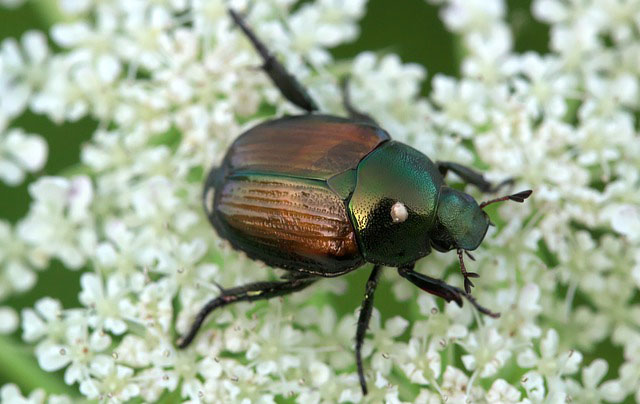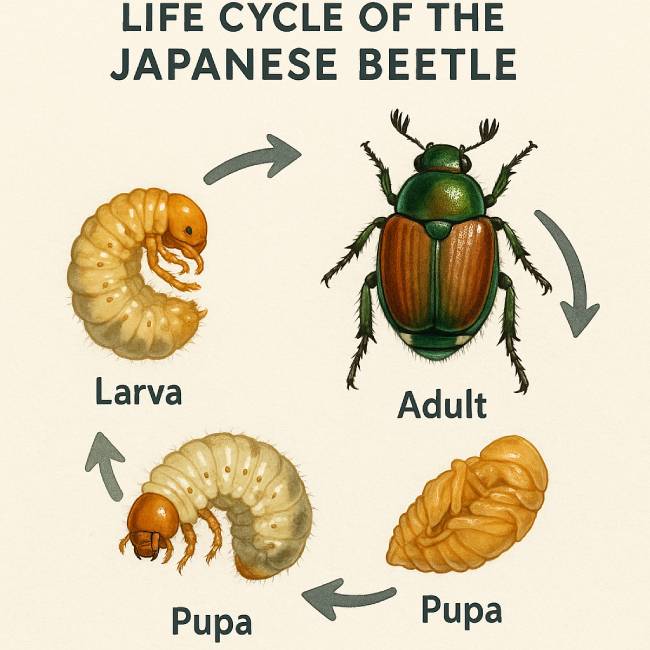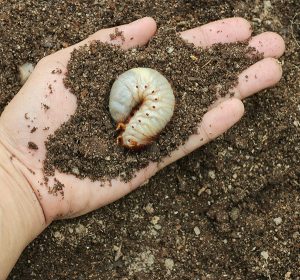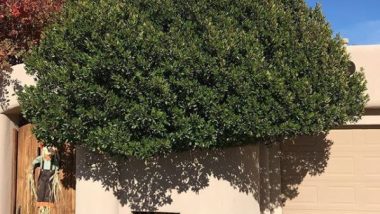Last updated on July 25th, 2025 at 02:43 pm
The Secret to Killing Grubs on your lawn. First, we must know where these ugly-looking worms come from. They come from the larvae of the Japanese beetle. They were introduced into the U.S. from of course Japan sometime in 1916 now almost all lawns throughout the USA have them. A few here and there are no big problem, but an infestation of them and your lawn will start to look bad. These larvae will also feed on the roots of other plants like roses, and small-type trees and shrubs.
The Adult Japanese Beetle

The adult beetle is also a pest that will eat the foliage of Oak trees, boxwoods, and roses. It is best to spray with a good insecticide to kill these flying insects. If you want to go organic use a Japanese beetle trap available at most nurseries or greenhouses in the U.S. So, if you kill or trap beetles there will be less chance of an infestation of larvae on your lawn.
The Cycle of the Japanese Beetle

Ok, so the female will lay its eggs in the soil in about June (AKA…June Bug). The eggs hatch and become grub larvae. They dig into lawns, and this is when they feed on the roots of your lawn. When the weather cools, they will go deeper into the dirt, lying dormant throughout the winter seasons. In the Southwest, spring comes around early. March is when they start feeding again.
When June comes around again, the grubs become adult beetles, they mate, and the female will lay more larvae eggs, and it starts all over again. June bugs have three life cycles.
How to tell if you have grubs?
If you notice skunks or birds, especially those pesky thrashers, tearing up your lawn, there’s a good chance your yard’s got a grub problem. These critters are after the grubs hiding beneath the grass, munching away at the roots. You might think it’s just wildlife being wild, but it’s a sign your lawn needs attention. Do you have patches of dying grass? That’s another clue. It’s not just a nuisance; it’s your lawn crying out for help. It’s time to roll up your sleeves and tackle those grubs before they do more damage. You can also tell by observing your lawn if you see round brown or yellow spots grubs are probably eating the root system of your lawn.

Where exactly are they?
It is rare to see grubs above ground. Typically, they are in the soil about 3-4 inches deep. You can tell where they have eaten the grassroots by the dull-grey-looking blades’ appearance and the good-looking green grass. See the image below.

The Secret to Killing Grubs
Bayer Advanced Season Long Grub Killer works. Formulated to work all season long from my own experience it’s best to apply it twice per year. It should be applied once in early spring and again in mid-fall.
Kill Grubs Organically
If you want something natural, go with beneficial nematodes. You can ask for them at your local nursery or garden store. People tell us these tiny worms really do the job, but you’ve got to use them just like the instructions say. Some folks worry that nematodes might mess with plants, but they only go after pests, not your veggies or flowers. Stick to the directions, and you should see pretty good results. These nematodes are microscopic insects that inject a type of bacteria inside the grub’s body. The bacteria cause blood poisoning, thus killing it.
Learn more about insects and diseases on plants.

Greenhouse Manager, Master Gardener, and Webmaster.
If you have any questions or enjoyed this post, feel free to share your thoughts in the comments below.



